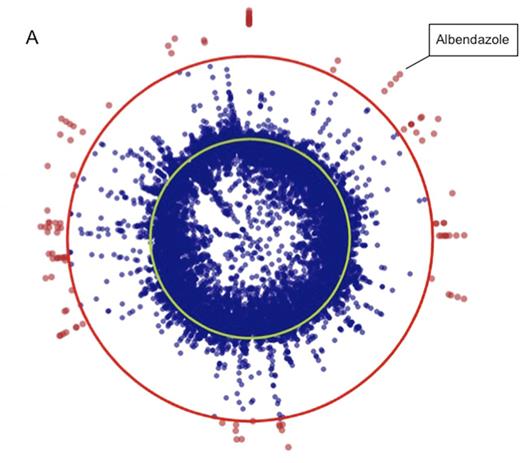Abstract
Objectives
Acute myeloid leukaemia (AML) is a progressive malignancy that arises from impaired differentiation of hematopoietic progenitor cells. While many AML patients respond to induction therapy, relapse and refractory disease is common (Dohner et al. 2015). Recent studies have defined the driver landscape in AML (Pappaemmanuil et al. 2016)and novel targeted therapies are emerging(Erb et al. 2017). Moreover, molecular profiling has revealed the genetic complexity of leukaemia development and progression with growing evidence of mutational hierarchies that dynamically evolve during therapy(Mossner et al. 2016). Therefore, while target-driven, de novo drug design holds promise for novel AML treatments, alternative strategies for developing AML therapies should be exploited, especially those that provide both efficacy and reduced toxicities.
Methods
In order to discover novel therapies for AML, we performed an FDA drug repurposing screen using 760 drugs on primary murine cell lines developed in our laboratory; models representative of AML with a t(9;11) (MLL-AF9) translocation) and AML with a normal karyotype (HOXA9-Meis 1 -driven).
Results
We identified 38 hits (5% of total) at 50% viability (Figure A), and these hits were validated in secondary screens. Of the candidates identified, 12 are established therapies in haematological malignancies, providing confirmation of the screen validity. These included cytarabine, danorubicin and idarubicin, standard of care therapies used in AML induction and maintenance therapy (Woelich et al. 2017). A further 12 drugs are currently used clinically in the treatment of solid tumours. The remaining 14 are novel to oncology therapy. We found the anthelmintic agent albendazole (ABZ) to have particular efficacy with limited toxicity, reducing viability and colony formation in murine leukaemia cells whilst having negligible effects in normal murine bone marrow cells. A clinically achievable low dose of ABZ (IC50 <350 nM) reduced viability in several human AML cell lines, such as THP-1 and OCI-AML3. Low dose ABZ caused G2/M arrest in AML cells, leading to caspase-dependent apoptosis as confirmed by PI and Annexin V-based flow cytometry. BH3 profiling of AML cells showed increased mitochondrial associated pro-death proteins following ABZ treatment, consistent with caspase-dependent cell death. Ex-vivo treatment of THP-1 pSLIEW cells transplanted into NSG mice showed decreased leukaemia burden and extended lifespan in the ABZ treated (315 nM) cohort (median survival = 53 days) compared to controls (30 days) (p=0.0002).
Discussion
In summary, ABZ has anti-leukaemia efficacy in both primary cells and cell lines representing a range of molecular subtypes of AML, with negligible effects shown in normal cells. Current and future studies are focused on understanding the molecular mechanism of ABZ in AML and further pre-clinical validation alone, and in combination with standard of care therapies.
No relevant conflicts of interest to declare.
Author notes
Asterisk with author names denotes non-ASH members.


This feature is available to Subscribers Only
Sign In or Create an Account Close Modal